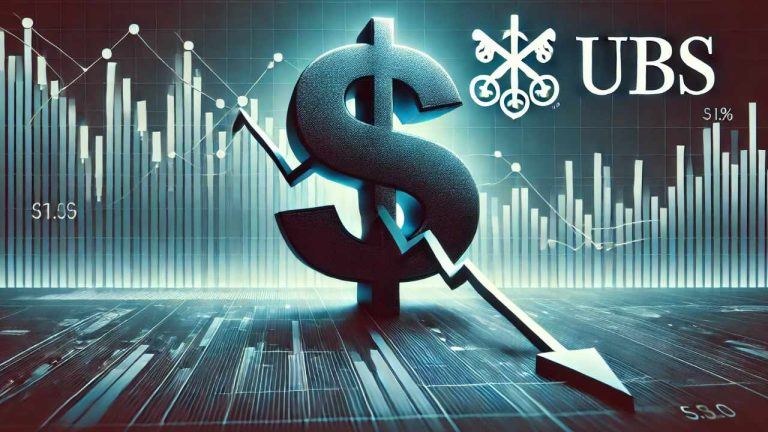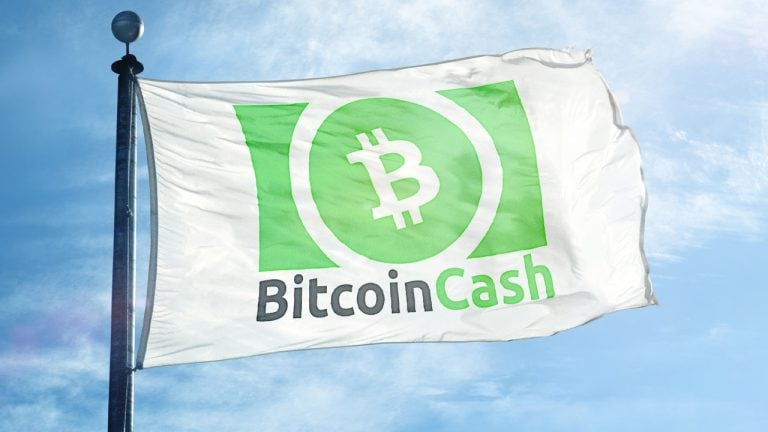 Financial giant UBS expects the U.S. dollar to continue to depreciate, advising investors to reevaluate their portfolios. The bank predicts a medium-term decline due to shrinking interest rate advantages and a growing fiscal deficit. With the dollar down 5% since June, UBS recommends strategies like currency hedging and diversifying into other currencies and assets like […]
Financial giant UBS expects the U.S. dollar to continue to depreciate, advising investors to reevaluate their portfolios. The bank predicts a medium-term decline due to shrinking interest rate advantages and a growing fiscal deficit. With the dollar down 5% since June, UBS recommends strategies like currency hedging and diversifying into other currencies and assets like […] On Tuesday, the crypto platform Umoja unveiled its beta version of hedging-as-a-service, designed to shield users from crypto losses. Umoja’s mission is to enhance the safety and accessibility of crypto investments, opening up hedging opportunities in a market valued at $500 trillion. Umoja Debuts Beta Hedging Platform The crypto platform Umoja has announced the beta […]
On Tuesday, the crypto platform Umoja unveiled its beta version of hedging-as-a-service, designed to shield users from crypto losses. Umoja’s mission is to enhance the safety and accessibility of crypto investments, opening up hedging opportunities in a market valued at $500 trillion. Umoja Debuts Beta Hedging Platform The crypto platform Umoja has announced the beta […]
JPMorgan’s CEO Jamie Dimon pointed to trading, hedging, research and error detection as just some of the processes that can be streamlined by AI.
JPMorgan CEO Jamie Dimon says artificial intelligence could be applied to “every single process” of his firm’s operations and may replace humans in certain roles.
In an Oct. 2 interview with Bloomberg, Dimon said he expects to see “all different types of models” and tools and technology for AI in the future. “It’s a living, breathing thing, he said, adding:
“But the way to think about for us is every single process, so errors, trading, hedging, research, every app, every database, you can be applying AI.”
“So it might be as a co-pilot, it might be to replace humans … AI is doing all the equity hedging for us for the most part. It’s idea generation, it’s large language models,” he said, adding more generally, it could also impact customer service.
"AI is real"
— Bloomberg (@business) October 2, 2023
JPMorgan CEO Jamie Dimon says artificial intelligence will be part of "every single process," adding it's already "doing all the equity hedging for us" https://t.co/EtsTbiME1a pic.twitter.com/J9YD4slOpv
“We already have thousands of people doing it,” said the JPMorgan CEO about AI research, including some of the “top scientists around the world.”
Asked whether he expects AI will replace some jobs, Dimon said “of course” — but stressed that technology has always done so.
“People need to take a deep breath. Technology has always replaced jobs,” he explained.
“Your children will live to 100 and not have cancer because of technology and literally they'll probably be working three days a week. So technology’s done unbelievable things for mankind.”
However, Dimon acknowledged there are also “negatives” to emerging technologies.
When it comes to AI, Dimon says he’s particularly concerned about “AI being used by bad people to do bad things” — particularly in cyberspace — but is hopeful that legal guardrails will curtail such conduct over time.
Related: AI tech boom: Is the artificial intelligence market already saturated?
Dimon concluded that AI will add “huge value” to the workforce and in the event that the firm replaces its employees with AI, he hopes they will be able to redeploy displaced workers in more suitable work environments.
“We expect to be able to get them a job somewhere local in a different branch or a different function, if we can do that, and we’ll be doing that with any dislocation that takes place as a result of AI.”
Magazine: AI Eye: Real uses for AI in crypto, Google’s GPT-4 rival, AI edge for bad employees
 As the Bitcoin Cash enthusiasts brace themselves for the much-awaited upgrade that vows to unleash decentralized applications, General Protocols revealed a complete production release of its decentralized hedging application, boasting a doubled contract size. Meanwhile, those utilizing the privacy-boosting protocol Cashfusion have fused over 17.4 million bitcoin cash since its inception, equivalent to a staggering […]
As the Bitcoin Cash enthusiasts brace themselves for the much-awaited upgrade that vows to unleash decentralized applications, General Protocols revealed a complete production release of its decentralized hedging application, boasting a doubled contract size. Meanwhile, those utilizing the privacy-boosting protocol Cashfusion have fused over 17.4 million bitcoin cash since its inception, equivalent to a staggering […]
One lawyer said that while stablecoins are meant to be stable, buyers may possibly profit from a range of arbitrage, hedging, and staking opportunities.
Recently reported planned enforcement action against Paxos by the United States Securities and Exchange Commission (SEC) over Binance USD (BUSD) has many in the community questioning how the regulator could see a stablecoin as a security.
Blockchain lawyers told Cointelegraph that while the answer isn't black and white, there exists an argument for it if the stablecoin was issued out in the expectation of profits or are derivatives of securities.
A report from the Wall Street Journal on Feb. 12 revealed that the SEC is planning to sue Paxos Trust Company in relation to its issuance of Binance USD, a stablecoin it created in partnership with Binance in 2019. Within the notice, the SEC reportedly alleges that BUSD is an unregistered security.
don't hate me but custodial stablecoins are probably all securities
— _gabrielShapir0 (@lex_node) February 13, 2023
I have said this consistently
US securities laws are just insanely broad...https://t.co/JDsB0v93Sw
Senior Lecturer Dr. Aaron Lane of RMIT’s Blockchain Innovation Hub told Cointelegraph that while the SEC may claim these stablecoins to be securities, that proposition hasn’t been conclusively tested by the U.S. Courts:
“With stablecoins, a particularly contentious issue will be whether the investment in the stablecoin led a person to an expectation of profit (the ‘third arm’ of the Howey test).”
“On a narrow view, the whole idea of the stablecoin is that it is stable. On a broader view, it could be argued that arbitrage, hedging, and staking opportunities provide an expectation of profit,” he said.
Lane also explained that a stablecoin may fall under U.S. securities laws in the event that it is found to be a derivative of a security.
This is something that SEC Chairman Gary Gensler emphasized strongly in July 2021 in a speech to the American Bar Association Derivative and Futures Law Committee:
“Make no mistake: It doesn’t matter whether it’s a stock token, a stable value token backed by securities, or any other virtual product that provides synthetic exposure to underlying securities.”
“These platforms — whether in the decentralized or centralized finance space — are implicated by the securities laws and must work within our securities regime,” he said at the time.
However Lane stressed that ultimately each case “will turn on its own facts,” particularly when adjudicating on an algorithmic stablecoin as opposed to a crypto or fiat-collateralized one.
A recent post by Quinn Emanuel Trial Lawyers has also approached the subject, explaining that in order to “ramp up” stablecoins to a “stable value,” they may sometimes be offered on discounted prior to sufficiently stabilizing.
“These sales may support an argument that initial purchasers, despite formal disclaimers by issuers and purchasers alike, buy with the intent for resale following stabilization at the higher price,” it wrote.

But while stablecoin issuers may resort to the courts to decide the dispute, many believe the SEC’s “regulation by enforcement” approach is simply uncalled for.
Digital assets lawyer and partner Michael Bacina of Piper Alderman told Cointelegraph that the SEC should instead provide “sensible guidance” to help the industry players who are seeking to be legally compliant:
“Regulation by enforcement is an inefficient way of meeting policy outcomes, as SEC Commissioner Peirce has recently observed in her blistering dissent in relation to the Kraken prosecution. When a rapidly growing industry doesn’t fit the existing regulatory framework and has been seeking clear pathways to compliance, then engagement and sensible guidance is a far superior approach than resorting to lawsuits.”
Cinneamhain Ventures partner Adam Cochran gave another view to his 181,000 Twitter followers on Feb. 13, noting that the SEC can sue any company that issues financial assets under the much broader Securities Act of 1933:
1/5
— Adam Cochran (adamscochran.eth) (@adamscochran) February 13, 2023
This is what people don't realize.
Howey test = precedent for investment contracts.
"Securities" is a much broader category defined by the 1933 Securities Act.
Honestly, if the SEC wants to, with how vague the act is, its fairly easy to put anything under it. https://t.co/TbHKqO3zLD
The digital asset investor then explained that the SEC isn’t restricted to the Howey Test:
“The fact that these assets hold underlying treasuries, makes them a lot like a money market fund, exposing holders to a security, even if they don't earn from it. Making an argument (not one I agree with, but a reasonable enough one) that they can be a security.”
“Worth fighting tooth and nail, but everyone who is shrugging this off as "lol the SEC got it wrong, this doesn't pass the Howey test" needs to re-eval. The SEC, believe it or not, has knowledgeable securities counsel,” he added.
Related: SEC chair compares stablecoins to casino poker chips
The latest reported planned action from the SEC comes after reports emerged on Feb. 10 that Paxos Trust was being investigated by the New York Department of Financial Services for an unconfirmed reason.
Commenting on the initial reports, a spokesperson for Binance said BUSD is a "Paxos issued and owned product" with Binance licensing its brand to the firm for use with BUSD. It added Paxos is regulated by the New York Department of Financial Services (NYDFS) and that BUSD is a "1 to 1 backed stablecoin."
"Stablecoins are a critical safety net for investors seeking refuge from volatile markets and limiting their access would directly harm millions of people across the globe," the spokesperson added. "We will continue to monitor the situation. Our global users have a wide array of stablecoins available to them.”
 The Basel Committee, the organization in charge of setting global bank standards, has finalized its new rules related to banks and cryptocurrency exposure. The document establishes two different crypto asset classes, including tokenized real assets and stablecoins in one, and other cryptocurrencies in another, discriminating on the collateral and quantity that banks might hold for […]
The Basel Committee, the organization in charge of setting global bank standards, has finalized its new rules related to banks and cryptocurrency exposure. The document establishes two different crypto asset classes, including tokenized real assets and stablecoins in one, and other cryptocurrencies in another, discriminating on the collateral and quantity that banks might hold for […]
As part of a broader inquiry into FTX's collapse, federal prosecutors are looking at the role that FTX and Alameda may have played in the fall of Terra LUNA.
United States federal prosecutors have reportedly begun investigating whether the collapse of the Terra ecosystem was in fact triggered by market manipulation tactics by former FTX CEO Sam Bankman-Fried.
According to a Dec. 7 report from The New York Times (NYT), the prosecutors — as part of a broader inquiry into FTX’s own collapse — are investigating whether Bankman-Fried’s empire intentionally caused a flood of “sell” orders on Terra’s algorithmic stablecoin TerraClassicUSD, USTC (formerly UST).
The sudden increase in UST sell orders were said to make it difficult to match them with corresponding “buy” orders, which in turn forced more downward price pressure on UST, causing it to depeg from its intended 1:1 ratio with the U.S. Dollar.
The events also led to the fall of Terra’s native token, Terra Classic, LUNC (formerly LUNA) as the two cryptocurrencies were designed to be linked.
But while no one has been able to precisely determine the root cause behind the collapse of LUNC and USTC in May, it is known that the majority of the USTC sell orders came from Bankman-Fried’s trading firm Alameda research, according to the NYT.
A person with knowledge on the matter also told NYT that Alameda Researched also placed a big bet on the price of LUNC falling.
Like with most comments Bankman-Fried has shared since FTX’s collapse, the former CEO claimed that he was “not aware of any market manipulation and certainly never intended to engage in market manipulation,” according to NYT.
“To the best of my knowledge, all transactions were for investment or for hedging,” he added.
Related: The nightmare continues for Sam Bankman-Fried and FTX — Law Decoded, Nov. 14-21
Responding to the recent report, Terraform Labs CEO Do Kwon shared his thoughts on the matter to his 1 million Twitter followers in a Nov. 8 tweet, who suggested it was time for Genesis Trading come clean about an alleged $1 billion loan in UST to “SBF or Alameda” shortly before Kwon’s Terra ecosystem crashed.
I think the time has come for @GenesisTrading to reveal if they provided the $1B UST shortly before the crash to SBF or Alameda - the purchase from LFG was represented as stemming from “interest to participate in the Terra Defi ecosystem” - not to provide ammo for a peg attack
— Do Kwon (@stablekwon) December 8, 2022
Kwon also stated that a large currency contraction that UST underwent in Feb. 2021 was started by Alameda “when they sold 500mm UST in minutes to drain its curve pools during the MIM crisis.”
“What’s done in darkness will come to light,” Kwon added on the matter.
 Just recently the developers behind the Bitcoin Cash-centric project Anyhedge released the alpha version of the Anyhedge Whitelabel and since then, 284 smart contracts were created onchain, and more than $32,900 in funds hedged using the alpha protocol. Furthermore, this month, General Protocols, the engineers behind Anyhedge, revealed the team plans to launch a decentralized […]
Just recently the developers behind the Bitcoin Cash-centric project Anyhedge released the alpha version of the Anyhedge Whitelabel and since then, 284 smart contracts were created onchain, and more than $32,900 in funds hedged using the alpha protocol. Furthermore, this month, General Protocols, the engineers behind Anyhedge, revealed the team plans to launch a decentralized […] Roughly seven weeks after Keyfi founder Jason Stone filed a lawsuit against the crypto lender Celsius, the company has filed a countersuit against Stone claiming that he stole millions from Celsius wallets and allegedly “pocketed seven-figure returns.” Stone’s attorney Kyle Roche says the lawsuit is an attempt to “rewrite history,” and to use Stone as […]
Roughly seven weeks after Keyfi founder Jason Stone filed a lawsuit against the crypto lender Celsius, the company has filed a countersuit against Stone claiming that he stole millions from Celsius wallets and allegedly “pocketed seven-figure returns.” Stone’s attorney Kyle Roche says the lawsuit is an attempt to “rewrite history,” and to use Stone as […] On July 7, 2022, the pseudonymous non-fungible token (NFT) collector known as “0xb1” published a Twitter thread that discusses the collector’s true identity and his relationship with the crypto lending firm Celsius. According to 0xb1, otherwise known as Jason Stone, his team found “major problems in how the company operated,” and Stone told Celsius his […]
On July 7, 2022, the pseudonymous non-fungible token (NFT) collector known as “0xb1” published a Twitter thread that discusses the collector’s true identity and his relationship with the crypto lending firm Celsius. According to 0xb1, otherwise known as Jason Stone, his team found “major problems in how the company operated,” and Stone told Celsius his […]